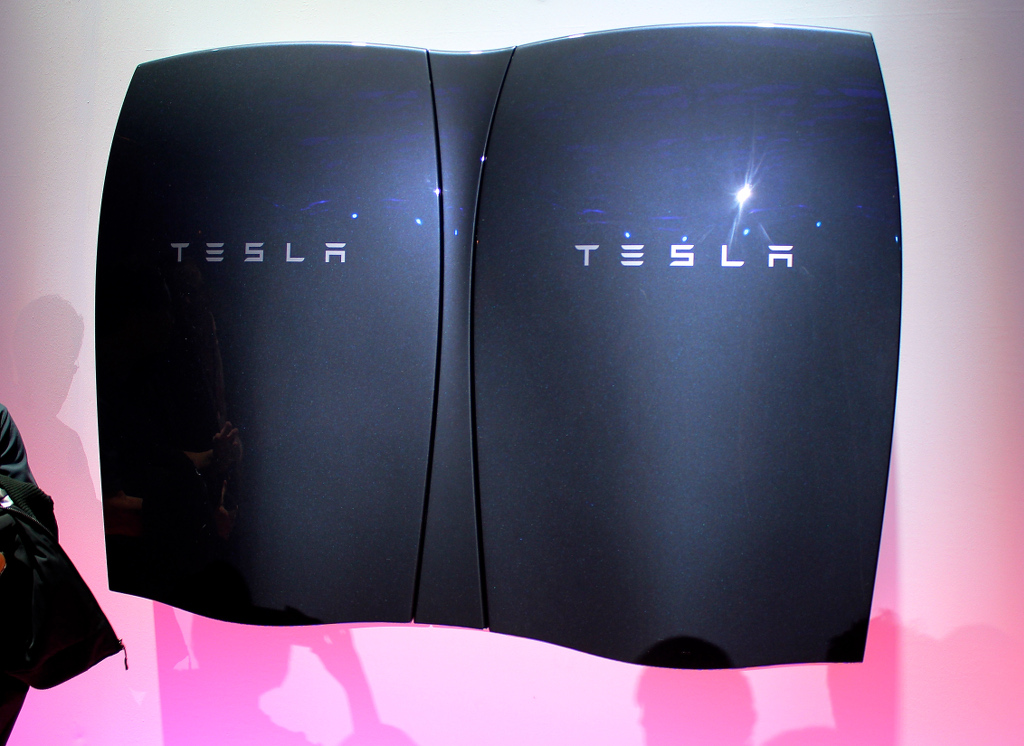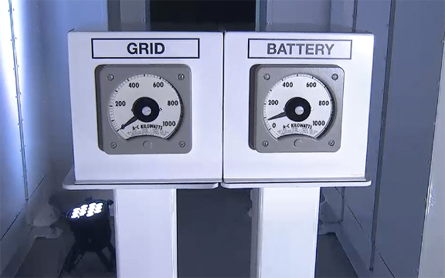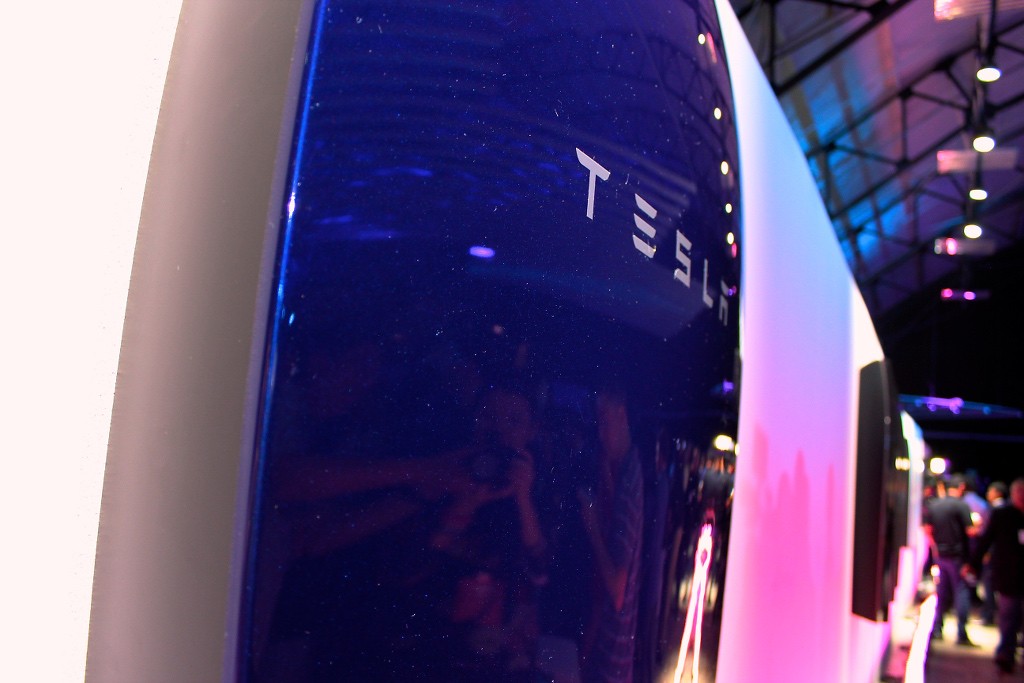News
Tesla Grabs Mind Share with Battery Storage Solutions


Most home owners aren’t looking to move off the grid, yet, charging with clean energy seems to be the biggest driving factor. (Photo Credit: Grant Gerke)
It’s been interesting to read and watch how corporate media, industry experts and financial analysts digest Tesla Energy’s battery storage solutions over the last seven days. Numerous media outlets are poking at Tesla’s business premise of a 7 and 10 kWH residential battery packs for your home, as they should be.
Here’s a very even-handed take by Dan Steigert, an energy professional, on the 7 kWh daily battery:
If you are getting this out of the battery every day for 10 years the price drops to $0.12/kWhr-cycle, again neglecting installation and inverter price. If this is truly the spec, this is an exceptional number. It is still more expensive than a genset—fossil fuel generator—because the genset can run @ $200/kW, and this is $1500/kW.
The residential battery packs are getting a LOT of attention, partly due to the lack of information at the PR event last Thursday in Hawthorne, Calif. For the last couple of months, I’ve been documenting the lack of a residential market for energy storage, think “community energy” and being able group 100 to 200 hundred solar houses and sell it back to the utility.
That residential market example doesn’t exist, yet.
However, utilities are fully engaged in offering commercial demand/response programs throughout the U.S to large companies and, since last Thursday, Tesla has received over 2,500 reservations for its PowerPack, the commercial and building storage solution.
Currently, Amazon is focusing on clean energy to power its data centers and will roll out a pilot program with Tesla Energy for 4.8 megawatts in Northern California. Tesla is also working with Jackson Family Wines and Target on pilot projects.
“As part of Target’s support to our communities, we’re excited to partner with Tesla on a pilot test at select Target stores to incorporate Tesla Energy Storage as part of our energy strategy,” says David Hughes, senior grp. mgr., Energy Management, Target.
So, yes, Tesla Energy has to deliver a real business solution with these pilot projects and, of course, margins need win out. During Tesla’s conference call, Musk said, “Once we get Gigafactory up and running, and high volume and get the economies of scale working, this is just a guess, but maybe it’s somewhere around 20 percent (battery margins). It’s like we just don’t have enough information to say exactly what that would be (at this point).”
Also from the conference call are the similarities between the car packs and Tesla Energy packs and how that could help economies-of-scale.
JB Straubel, CTO at Tesla Energy, says, “Maybe one point on the cost structure. There’s definitely a lot of commonality in the supply chain and even in the manufacturing base on how we do the modules and sales for the Tesla Energy products along with the vehicle products.”
Sounds promising, especially when Tesla is on record saying it should drive down battery costs by 30% when the Gigafactory is fully operational.
So, the company has to deliver but mind share is already there for the Silicon Valley company and its energy storage products. According to Bloomberg, Tesla Energy’s current reservations–no money down is needed–for both the home and commercial products would equate to $800 million if they could deliver immediately.
Ten years from now, who’s going to get credit for leading the clean energy battery storage drive? I doubt Panasonic and Sony and their much pricier battery storage solutions would roll off your tongue.

News
Tesla (TSLA) receives “Buy” rating and $551 PT from Canaccord Genuity
He also maintained a “Buy” rating for TSLA stock over the company’s improving long-term outlook, which is driven by autonomy and robotics.

Canaccord Genuity analyst George Gianarikas raised his Tesla (NASDAQ:TSLA) price target from $482 to $551. He also maintained a “Buy” rating for TSLA stock over the company’s improving long-term outlook, which is driven by autonomy and robotics.
The analyst’s updated note
Gianarikas lowered his 4Q25 delivery estimates but pointed to several positive factors in the Tesla story. He noted that EV adoption in emerging markets is gaining pace, and progress in FSD and the Robotaxi rollout in 2026 represent major upside drivers. Further progress in the Optimus program next year could also add more momentum for the electric vehicle maker.
“Overall, yes, 4Q25 delivery expectations are being revised lower. However, the reset in the US EV market is laying the groundwork for a more durable and attractive long-term demand environment.
“At the same time, EV penetration in emerging markets is accelerating, reinforcing Tesla’s potential multi‑year growth runway beyond the US. Global progress in FSD and the anticipated rollout of a larger robotaxi fleet in 2026 are increasingly important components of the Tesla equity story and could provide sentiment tailwinds,” the analyst wrote.
Tesla’s busy 2026
The upcoming year would be a busy one for Tesla, considering the company’s plans and targets. The autonomous two-seat Cybercab has been confirmed to start production sometime in Q2 2026, as per Elon Musk during the 2025 Annual Shareholder Meeting.
Apart from this, Tesla is also expected to unveil the next-generation Roadster on April 1, 2026. Tesla is also expected to start high-volume production of the Tesla Semi in Nevada next year.
Apart from vehicle launches, Tesla has expressed its intentions to significantly ramp the rollout of FSD to several regions worldwide, such as Europe. Plans are also underway to launch more Robotaxi networks in several more key areas across the United States.
News
Waymo sues Santa Monica over order to halt overnight charging sessions
In its complaint, Waymo argued that its self-driving cars’ operations do not constitute a public nuisance, and compliance with the city’s order would cause the company irreparable harm.

Waymo has filed a lawsuit against the City of Santa Monica in Los Angeles County Superior Court, seeking to block an order that requires the company to cease overnight charging at two facilities.
In its complaint, Waymo argued that its self-driving cars’ operations do not constitute a public nuisance, and compliance with the city’s order would cause the company irreparable harm.
Nuisance claims
As noted in a report from the Los Angeles Times, Waymo’s two charging sites at Euclid Street and Broadway have operated for about a year, supporting the company’s growing fleet with round-the-clock activity. Unfortunately, this has also resulted in residents in the area reportedly being unable to sleep due to incessant beeping from self-driving taxis that are moving in and out of the charging stations around the clock.
Frustrated residents have protested against the Waymos by blocking the vehicles’ paths, placing cones, and “stacking” cars to create backups. This has also resulted in multiple calls to the police.
Last month, the city issued an order to Waymo and its charging partner, Voltera, to cease overnight operations at the charging locations, stating that the self-driving vehicles’ activities at night were a public nuisance. A December 15 meeting yielded no agreement on mitigations like software rerouting. Waymo proposed changes, but the city reportedly insisted that nothing would satisfy the irate residents.
“We are disappointed that the City has chosen an adversarial path over a collaborative one. The City’s position has been to insist that no actions taken or proposed by Waymo would satisfy the complaining neighbors and therefore must be deemed insufficient,” a Waymo spokesperson stated.
Waymo pushes back
In its legal complaint, Waymo stated that its “activities at the Broadway Facilities do not constitute a public nuisance.” The company also noted that it “faces imminent and irreparable harm to its operations, employees, and customers” from the city’s order. The suit also stated that the city was fully aware that the Voltera charging sites would be operating around the clock to support Waymo’s self-driving taxis.
The company highlighted over one million trips in Santa Monica since launch, with more than 50,000 rides starting or ending there in November alone. Waymo also criticized the city for adopting a contentious strategy against businesses.
“The City of Santa Monica’s recent actions are inconsistent with its stated goal of attracting investment. At a time when the City faces a serious fiscal crisis, officials are choosing to obstruct properly permitted investment rather than fostering a ‘ready for business’ environment,” Waymo stated.
News
Tesla FSD v14.2.2 is getting rave reviews from drivers
So far, early testers have reported buttery-smooth drives with confident performance, even at night or on twisty roads.

Tesla Full Self-Driving (Supervised) v14.2.2 is receiving positive reviews from owners, with several drivers praising the build’s lack of hesitation during lane changes and its smoother decision-making, among others.
The update, which started rolling out on Monday, also adds features like dynamic arrival pin adjustment. So far, early testers have reported buttery-smooth drives with confident performance, even at night or on twisty roads.
Owners highlight major improvements
Longtime Tesla owner and FSD user @BLKMDL3 shared a detailed 10-hour impression of FSD v14.2.2, noting that the system exhibited “zero lane change hesitation” and “extremely refined” lane choices. He praised Mad Max mode’s performance, stellar parking in locations including ticket dispensers, and impressive canyon runs even in dark conditions.
Fellow FSD user Dan Burkland reported an hour of FSD v14.2.2’s nighttime driving with “zero hesitations” and “buttery smooth” confidence reminiscent of Robotaxi rides in areas such as Austin, Texas. Veteran FSD user Whole Mars Catalog also demonstrated voice navigation via Grok, while Tesla owner Devin Olsen completed a nearly two-hour drive with FSD v14.2.2 in heavy traffic and rain with strong performance.
Closer to unsupervised
FSD has been receiving rave reviews, even from Tesla’s competitors. Xpeng CEO He Xiaopeng, for one, offered fresh praise for FSD v14.2 after visiting Silicon Valley. Following extended test drives of Tesla vehicles running the latest FSD software, He stated that the system has made major strides, reinforcing his view that Tesla’s approach to autonomy is indeed the proper path towards autonomy.
According to He, Tesla’s FSD has evolved from a smooth Level 2 advanced driver assistance system into what he described as a “near-Level 4” experience in terms of capabilities. While acknowledging that areas of improvement are still present, the Xpeng CEO stated that FSD’s current iteration significantly surpasses last year’s capabilities. He also reiterated his belief that Tesla’s strategy of using the same autonomous software and hardware architecture across private vehicles and robotaxis is the right long-term approach, as it would allow users to bypass intermediate autonomy stages and move closer to Level 4 functionality.









